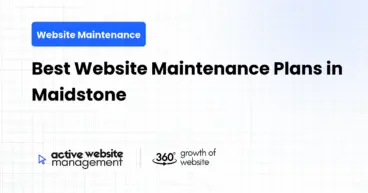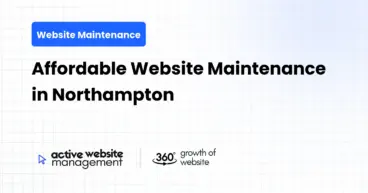January 31, 2025
14 min read
Running a local bakery is a labor of love, a daily dance of flour, sugar, and passion. You craft delectable treats that bring joy to your community. But in today’s digital world, a beautiful storefront isn’t enough. Your website is your online bakery, and just like your physical shop, it needs consistent care to thrive. Neglecting it is like leaving your ovens uncleaned – things can quickly go stale. That’s why implementing solid website maintenance practices is crucial. In this guide, we’ll knead through seven essential practices to keep your bakery’s website fresh, inviting, and effective, making sure your online presence is just as tempting as your creations.
Imagine walking into a bakery with a dusty, outdated menu. You might wonder if they’re even still baking. Your website’s content is the same: it tells your story, showcases your offerings, and engages your customers. Stale information can leave visitors feeling neglected, leading them straight to your competitors. Keeping your content current is a cornerstone of effective bakery website upkeep. This includes updating your:
Your menu is perhaps the most crucial element. It’s the first place many customers go to see what you offer and how much it costs. When was the last time you reviewed it? Here’s why updates are vital:
- Seasonal Specials: Did you introduce a pumpkin spice latte for fall or a refreshing berry tart for summer? Update your website to reflect these seasonal delights. Use high-quality, mouth-watering photos to make them irresistible. This enhances your dessert shop care routine.
- Price Adjustments: Prices of ingredients fluctuate. Keep your online menu accurate to avoid customer dissatisfaction and confusion. Clearly communicate any price changes on your site.
- New Additions: Introduce a new vegan cake or gluten-free bread? Shout it from the digital rooftops! Make sure these are prominently displayed on your menu and related pages.
How to Update Your Menu:
- Review Regularly: Set a monthly reminder to review and update your menu.
- Use Clear Language: Avoid jargon. Describe your treats with tempting, descriptive words that appeal to the senses.
- High-Quality Photos: Every product should have a photo that looks good enough to eat. Use natural light and clear angles.
- Mobile Optimization: Ensure your menu is easy to view and navigate on mobile devices. Most people will browse on their phones.
b. Blog Posts and Articles: Engaging Your Audience
A blog can be your bakery’s secret weapon. It’s a fantastic place to share your passion, engage with your community, and improve your search engine ranking for relevant terms, which is crucial for effective pastry store maintenance.
- Behind-the-Scenes: Share your baking process, the origin of your ingredients, or your favorite recipes. Customers love to connect with the faces behind their treats.
- Holiday Themes: Create themed blog posts for holidays (like Valentine’s Day or Christmas) with special offers, recipes, or tips related to baking at home.
- Customer Spotlights: Feature happy customers, local events you’ve catered, or partnerships with other businesses in your community. This builds social proof and expands your reach.
- Keyword Integration: Use keywords naturally within your blog content (such as “best chocolate cake in [your city]” or “local bakery near me”) to improve your website’s visibility in search engines.
Actionable Tips for Blog Posts:
- Brainstorm Ideas: Create a list of topics that would interest your customers and represent your brand.
- Schedule Regularly: Aim to publish a blog post once or twice a month to keep your content fresh.
- Promote on Social Media: Once you publish, share the post on your social media channels to drive traffic to your website.
- Engage with Comments: Respond to comments and questions from your readers. It builds a sense of community around your bakery.
Don’t Just Maintain Your Website—
Grow It using Active Website Management! Don't Wait for Growth—Accelerate It with Active Website Management
c. About Us Page: Telling Your Story
Your “About Us” page is more than just a formality; it’s your chance to tell your unique story and build a personal connection with visitors. This essential part of bakery website upkeep is often overlooked.
- Share Your Passion: Explain why you started baking. Was it a family tradition? A love for local ingredients? Let your passion shine through.
- Meet the Team: Showcase the faces behind your delicious treats. Include photos and short bios of your bakers and staff.
- Highlight Local Connections: Discuss any partnerships with local farms or suppliers to demonstrate your commitment to the community.
Key Tips for a Compelling “About Us” Page:
- Authenticity: Speak from the heart and let your unique personality shine.
- Professional Photos: Use high-quality photos of yourself, your team, and your bakery.
- Keep It Updated: Ensure your story reflects any significant milestones, awards, or growth in your bakery.
2. Optimize Your Website for Search Engines (SEO): Helping Customers Find You
Having a beautifully designed website is great, but it doesn’t mean much if customers can’t find it. Search Engine Optimization (SEO) is the process of making your website visible in search engine results. It’s a key component of good dessert shop care and ensures that your online presence is working for you.
a. Keyword Research: Understanding Your Customers’ Language
The first step in SEO is understanding how customers are searching for bakeries like yours. This means researching relevant keywords.
- Local Keywords: Focus on location-based keywords like “[your city] bakery,” “[your neighborhood] pastries,” or “best cake shop near me.”
- Product Keywords: Use words that describe your offerings, like “chocolate cupcakes,” “gluten-free bread,” or “custom birthday cakes.”
- Long-Tail Keywords: These are longer, more specific phrases like “vegan chocolate cake delivery in [your city]” or “where to buy fresh sourdough bread near [your neighborhood].”
- Use Keyword Research Tools: Tools like Google Keyword Planner, SEMrush, or Ahrefs can help you identify popular and relevant keywords.
b. On-Page Optimization: Making Your Content Search-Engine Friendly
Once you have your keywords, it’s time to incorporate them into your website’s content. This is known as on-page optimization and is vital for pastry store maintenance.
- Page Titles & Meta Descriptions: Craft compelling titles and descriptions for each page on your website. Use relevant keywords, keep them concise and engaging.
- Header Tags (H1, H2, H3): Use header tags to structure your content and help search engines understand your page hierarchy. Use your primary keywords in headers where it feels natural.
- Image Alt Text: Add descriptive alt text to your images. This helps search engines understand what the images are about. Use keywords when appropriate.
- Content Optimization: Include your targeted keywords naturally throughout your website’s text, including descriptions of your products and services.
- Internal Linking: Link relevant pages together within your site to improve navigation and SEO.
If your business is a local bakery, then Local SEO is very important. This helps you get seen by nearby potential customers. This is an essential part of bakery website upkeep.
- Google My Business (GMB): Claim and optimize your GMB profile. Include accurate contact information, your business hours, photos, and customer reviews.
- Local Citations: List your business on relevant online directories and websites (e.g. Yelp, TripAdvisor).
- NAP Consistency: Ensure your business name, address, and phone number (NAP) are consistent across all online platforms.
- Encourage Reviews: Ask satisfied customers to leave reviews on Google and other review sites.
3. Ensure Your Website is Mobile-Friendly: Catering to On-the-Go Customers
More and more people browse the internet on their smartphones and tablets. A website that is not mobile-friendly is like a bakery that only opens its doors halfway – you’re losing customers. Making sure your website is easy to use on all devices is crucial for good dessert shop care and is called responsive design.
a. Responsive Design: Adjusting to Every Screen Size
A responsive design means your website automatically adjusts its layout to fit the screen size of the device it’s being viewed on.
- Easy Navigation: Ensure menus and navigation bars are easy to use on smaller screens.
- Readable Text: Text should be easy to read without zooming.
- Fast Loading: Optimize images and code to keep your website loading quickly on mobile networks.
- Clickable Elements: Buttons and links should be large enough to click with a finger.
b. Mobile-First Approach: Thinking Mobile First
Rather than just making your desktop website work on mobile, you should design it with mobile in mind first. This means:
- Simplified Layout: Keep the mobile version of your website clean and focused.
- Essential Information First: Ensure your hours, contact details, and menu are easy to access on mobile.
- Mobile-Friendly Forms: Contact and order forms should be easy to fill out on a mobile screen.
- Test on Different Devices: Regularly test your website on various mobile devices to ensure it looks and functions correctly.
4. Regular Security Updates: Protecting Your Bakery’s Online Space
In the digital age, your website is vulnerable to security threats. Just like your physical shop needs locks and security measures, your website needs protection too. Neglecting security is like leaving your bakery’s cash register unlocked and open – it’s an invitation to trouble. Regular security updates are non-negotiable for pastry store maintenance.
Don't Wait for Growth—Accelerate It with
Active Website Management Don't Wait for Growth—Accelerate It with Active Website Management
a. Software and Plugin Updates: Keeping Things Current
Your website is built on software and plugins that require regular updates to patch security vulnerabilities and enhance functionality.
- Content Management System (CMS): Keep your CMS (e.g., WordPress, Shopify, Squarespace) up to date.
- Plugins and Extensions: Regularly update all plugins and extensions used on your website. Remove any outdated or unused ones.
- Themes and Templates: Keep your website theme or template up-to-date with the latest version.
b. SSL Certificate: Securing Customer Data
An SSL certificate encrypts data transmitted between your website and visitors’ browsers, protecting sensitive information like customer orders and payment details.
- HTTPS Protocol: Ensure your website uses the HTTPS protocol (rather than HTTP).
- Look for the Padlock Icon: Visitors can verify that your website is secure by checking for the padlock icon in the address bar.
c. Strong Passwords and Access Control: Protecting Your Backend
Protect access to your website’s administrative areas by using strong passwords and limiting access to only necessary personnel.
- Unique Passwords: Use strong, unique passwords for your website’s admin panel and database. Avoid using easily guessed passwords.
- Regular Password Changes: Change your website passwords periodically.
- Limit User Access: Provide access to only those who need it. Use different user roles with different permission levels.
d. Regular Backups: Having a Safety Net
Regularly backing up your website is essential. This allows you to quickly restore your website in the event of a hacking incident, software failure, or accidental data loss.
- Automated Backups: Set up automated backups on a daily or weekly basis.
- Offsite Backups: Store your website backups on a separate server or cloud storage.
- Test Restores: Regularly test your backups to ensure you can restore your website if needed.
Your website’s performance is critical for a good user experience and search engine rankings. A slow or buggy website can turn away potential customers, so this is a key part of bakery website upkeep.
a. Page Loading Speed: Keeping Customers Engaged
A slow-loading website can be frustrating for visitors. Make sure your website loads quickly on all devices and internet speeds.
- Optimize Images: Compress images to reduce their file size without compromising quality.
- Use Caching: Implement browser caching to speed up page loading for returning visitors.
- Minify Code: Remove unnecessary code and formatting from HTML, CSS, and JavaScript files.
- Choose a Fast Web Host: Opt for a reliable web hosting provider with fast servers.
- Test Your Website Speed: Use tools like Google PageSpeed Insights to identify areas for improvement.
b. Website Analytics: Understanding Your Visitors
Website analytics provide valuable data about how visitors interact with your website.
- Google Analytics: Set up Google Analytics to track website traffic, page views, user behavior, and more.
- Track Key Metrics: Monitor metrics such as bounce rate, time on page, and conversion rates.
- Identify Trends: Use the data to identify areas for improvement and to understand user behavior.
c. Broken Links and Errors: Ensuring a Smooth Experience
Regularly check for broken links and errors on your website. These can harm user experience and your search engine ranking.
- Use Link Checkers: Use tools like Broken Link Checker to scan your website for broken links.
- Monitor Error Logs: Check your website’s error logs to identify any technical problems.
- Regularly Test Functionality: Ensure all forms, buttons, and links on your website are working correctly.
6. Engage with Your Customers: Building Relationships Online
Your website is more than just a brochure; it’s a communication platform. Engaging with your customers online is a key part of good dessert shop care and helps you build relationships and brand loyalty.
Make it easy for customers to contact you with questions or feedback.
- Visible Contact Form: Ensure your contact form is prominently displayed on your website.
- Contact Information: Include your phone number, email address, and physical address in your website’s footer and contact page.
- Prompt Responses: Respond to customer inquiries in a timely manner.
Social media platforms provide a great opportunity to engage with your customers.
- Social Media Icons: Display icons on your website linking to your social media profiles.
- Embed Social Media Feeds: Embed your social media feed directly on your website.
- Share Website Content: Share blog posts and other website content on social media.
c. Customer Reviews and Testimonials: Building Trust
Positive reviews and testimonials can significantly influence new customers.
- Display Testimonials: Display positive testimonials from satisfied customers on your website.
- Encourage Reviews: Ask happy customers to leave reviews on Google, Yelp, and other platforms.
- Respond to Reviews: Respond to all reviews, both positive and negative. Acknowledge and address any concerns.
7. Active Website Management: Continuous Growth and Improvement
Website maintenance is not a one-time project; it’s an ongoing process. Active website management involves regularly updating, optimizing, and improving your website to stay ahead of the curve. It ensures your online presence is not only maintained but is actively growing, something which will help you with your pastry store maintenance in the long run.
a. Regular Website Audits: Keeping a Close Eye
Conduct regular website audits to identify areas for improvement.
- SEO Audit: Evaluate your website’s SEO performance.
- Content Audit: Review your website content for accuracy and relevance.
- Technical Audit: Check for errors, broken links, and slow-loading pages.
- Usability Audit: Assess the user experience of your website.
b. Continuous Optimization: Staying Ahead of the Curve
Continuously optimize your website based on the data from your audits and analytics.
- A/B Testing: Test different website layouts, calls to action, and designs to identify what works best.
- Content Updates: Regularly update your content with fresh, relevant information.
- SEO Adjustments: Adjust your SEO strategy as search engine algorithms evolve.
- Website Design: Keep your website design fresh and modern.
c. Leveraging Professional Assistance: When to Bring in Experts
You might be comfortable managing the basics, but there are times when it makes sense to seek professional help.
- Time Constraints: Managing website maintenance in addition to running your bakery can be time-consuming. Consider outsourcing some tasks.
- Technical Expertise: For complex technical issues, it may be best to enlist the help of a web developer or SEO specialist.
- Strategic Growth: If you are looking to scale your business, an expert can help you with a more focused plan.
Active Website Management understands the unique needs of local businesses like yours. They can provide you with expert help and support. They offer solutions tailored for the bakery industry, making sure that your website is not just functional, but it’s a tool that grows your business. Whether it’s keeping your website secure and up-to-date, or improving your search engine rankings, Active Website Management can help you get it done. They can take the weight of website care off your shoulders so you can focus on baking those amazing treats.
By implementing these 7 best practices, you’ll ensure your bakery’s website is not just a digital placeholder, but a powerful tool that brings more customers to your door (and ovens). Remember, consistent care and attention to your online presence will help you thrive in today’s competitive market. Keep your website fresh, engaging, and functional, and you’ll have a digital bakery that’s as successful as your physical one!







